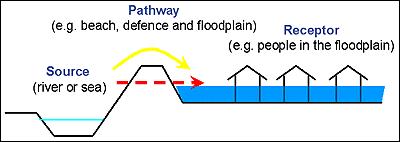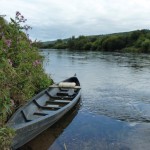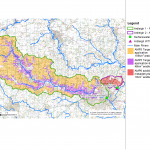We would like to thank all the attendees and especially…
Ireland’s Catchment Flood Risk Assessment and Management (CFRAM) Programme
Ireland’s Catchment Flood Risk Assessment and Management (CFRAM) Programme is central to the medium and long-term strategy for the reduction and management of flood risk throughout Ireland. It delivers core components of the National Flood Policy whilst also meeting the requirements of the EU Floods Directive. This article was originally published in March 2016.
The programme is funded and managed by the Office of Public Works who, as competent authority, are responsible for reporting, coordination and consultation under the Floods Directive.
Preliminary Flood Risk Assessment
This initial stage saw an extensive national programme of data collection and analysis to identify the areas where flood risk would be further assessed. A national, formal consultation was undertaken in 2011.
Flood Hazard and Risk Mapping
A Catchment Flood Risk Assessment and Management study was commissioned in each River Basin District. Data collection included historic flood event and rainfall records, high resolution floodplain surveying, and detailed channel/structure surveys of selected rivers. Hydraulic models determined flood hazard (where rivers or the sea is likely to flood in extreme events) and flood risk (the resultant impact on people, the economy and the environment). Flood mapping was presented at a series of Public Consultation Days held in 2014 and early 2015 and a national, formal consultation closed in late 2015.

Flood Risk Management Options
The Catchment Flood Risk Assessment and Management Studies tested a range of options against flood risk management objectives to identify potential solutions. Flood risk management objectives were agreed after formal public consultation in 2014. These involved further assessment of flood risk management in line with social, environmental, economic and technical objectives.
Options considered include high level measures to prevent future risk and detailed protection measures. The options comprise both structural and/or non-structural measures which have been identified for the sustainable management of flood risk. Project options were presented at a series of Public Consultation Days in 2015 and early 2016; seeking comments about the options from stakeholders and the public.
Flood Risk Management Plans
The findings of the options consultation stage will inform draft Flood Risk Management Plans proposing a list of ‘Preferred Options’ that are tailored to each community; and which take into account those elements which are most important to each area (i.e. local economic activity, community facilities, infrastructure, the environment and local cultural heritage). A further series of project Public Consultation Days, together with a national, formal consultation, will be held in summer 2016; at which the Catchment Flood Risk Assessment and Management Studies will be seeking comments about the draft plan from stakeholders and the public. The findings of the draft plan consultations will inform the development of a final plan in late 2016.
Floods/Water Framework Directive Integration
The Catchment Flood Risk Assessment and Management Programme has necessitated an ambitious degree of data collection and analysis meaning that there are new datasets available potentially to support Water Framework Directive assessment; this includes hydromorphological data: surveys of river longitudinal and cross-section, channel and bank structures (bridge and weir geometry); hydrological analysis resulting in improving of some rating relationships, and understanding of catchment boundaries and possibly response; hydraulic analysis predictions of water levels, extent and velocity may enhance the understanding of the fate of combined sewer overflow discharges and flooding risk of utility assets possibly facilitating future integrated flood risk management approaches; data on the maintenance/siltation of rivers and estuaries.
Like the Water Framework Directive, the Floods Directive has a six-yearly review cycle. This first cycle of Floods Directive implementation has focussed on the areas with the most significant risk and by definition these are mainly the urban areas where the flood risk receptors are most concentrated. Consequently, where structural measures are found to be the preferred flood risk management solution, it may be that measures can be mitigated such that they will not represent a critical morphological pressure.
To this end the assessment of alternative flood risk management options integrates the Water Framework Directive within the environmental objectives of a multi-criteria analysis that also considers social, economic and technical criteria. A particular opportunity that was headlined for interaction in the first Water Framework and Floods Directive cycles was the possibility of “win-win” measures, namely those which might jointly aid the management of quantity and quality pressures.

Natural Flood Management measures include activities such as silt trapping, drain blocking, slowing of flow and other land use adjustments – the potential applicability of such measures is being assessed in order that catchments, suitable to pilot these approaches, can be identified and the measures trialled in an Irish context.
In particular these measures might offer benefits in the climate change adaptability of flood risk management as well as affording opportunities for the Integrated Catchment Management approach being promoted by the EPA to support stakeholder engagement in Water Framework Directive implementation.
The Flood Risk Management Plans will, of course, be subject to Strategic Environmental Assessment and Habitats Directive Assessment, thus enabling their potential interaction with River Basin Management Plans, other spatial plans, and conservation plans and programmes to be considered and perhaps enhanced by ensuring policy and plan linkage.
The severe flooding in late December 2015 and New Year 2016 has heightened the publics’ interest in flood risk management. Consultation activities offer an obvious and key opportunity for interaction between these two Directives.
The Catchment Flood Risk Assessment and Management Programme is reaching an exciting stage, the findings of the significant volume of technical work are pointing towards preferred options to manage flood risk and the time to review, comment and influence Flood Risk Management Planning and find opportunities to interact is during the summer of 2016. Details of the Floods Directive consultations are made available at www.cfram.ie







